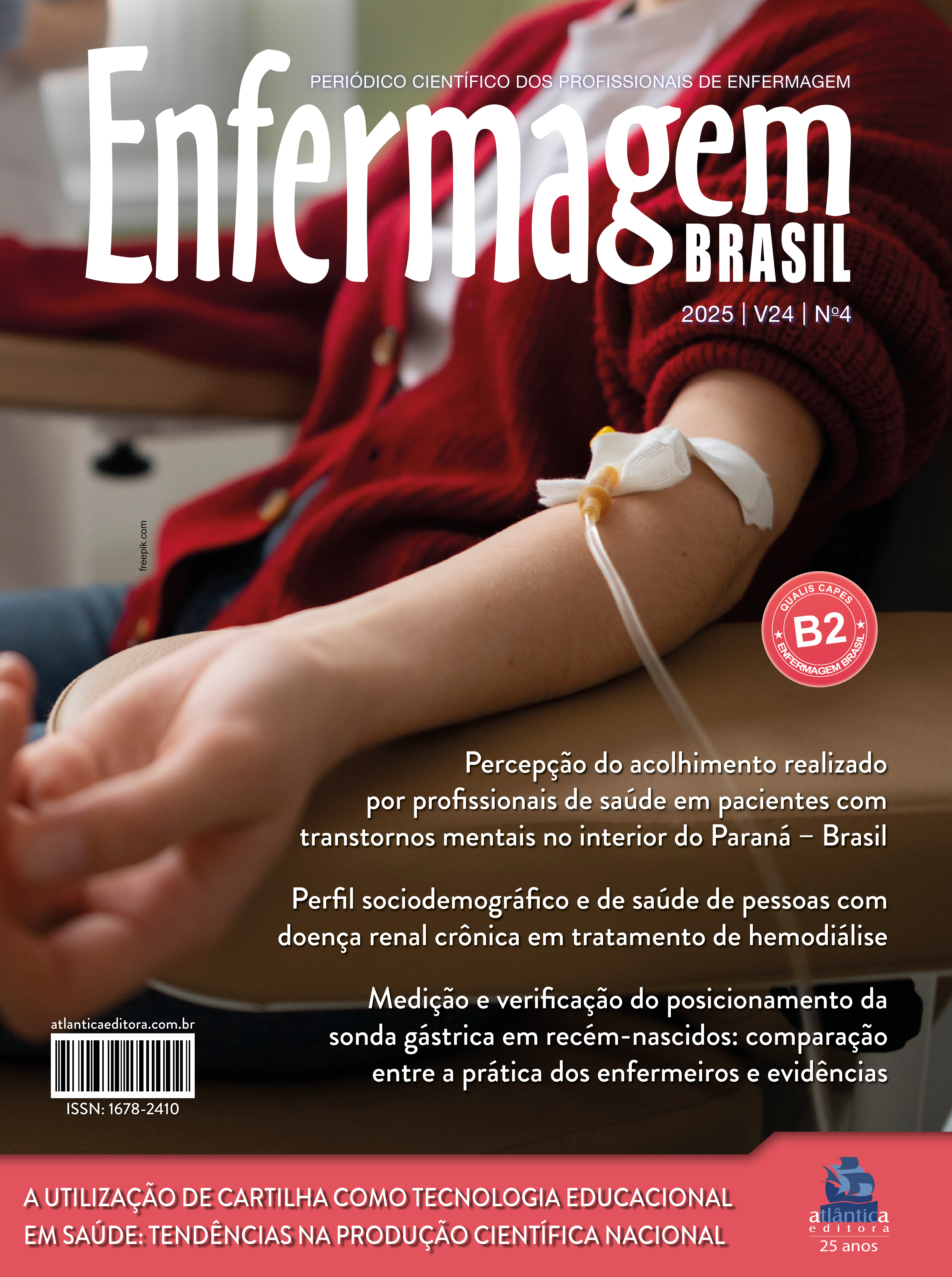Tuberculosis: what's new in treatment and clinical Monitoring
DOI:
https://doi.org/10.62827/eb.v24i4.4087Keywords:
Disease Management; Mycobacterium Tuberculosis; Treatment; Tuberculosis.Abstract
Introduction: Tuberculosis remains a major global public health problem due to its high incidence and mortality, especially in developing countries. Objective: To analyze new approaches to the treatment and clinical monitoring of tuberculosis in Brazil. Methods: The articles were searched in the Scientific Electronic Library Online (SciELO), US National Library of Medicine (PubMed), and Latin American and Caribbean Literature in Health Sciences (LILACS). Studies published between 2017 and 2025, in Portuguese or English, that directly addressed the topic were included. The search was conducted using the keywords “tuberculosis,” “Mycobacterium tuberculosis,” “innovative treatments,” and “clinical management.” Duplicate articles, publications prior to 2017, and those that did not directly address the pathology were excluded. In the end, 15 studies were analyzed. Results: The studies analyzed highlighted the main innovative approaches to the treatment of tuberculosis, including new pharmacological therapies, clinical monitoring strategies, and advanced diagnostic methods. The development of new therapeutic regimens for multidrug-resistant cases and the improvement of patient monitoring techniques were identified as relevant advances in the area. Conclusion: Innovations in the treatment and clinical monitoring of tuberculosis are essential for disease control, especially in vulnerable populations. The integration of new therapies, early diagnosis and improved clinical monitoring contributes to better outcomes in tuberculosis management.
References
World Health Organization (WHO). Global Tuberculosis Control: WHO Report 2020. Geneva: WHO; 2020. Disponível em: https://www.scielo.br/j/pcp/a/nzLTSHjFFvb7BWQB4YmtSmm/?lang=pt
Alves Filho P, Costa R, Lima L. Desigualdades socioespaciais relacionadas à tuberculose no município de Itaboraí, Rio de Janeiro. Rev Bras Epidemiol. 2017;20(4):559-72.
Silva JA, Oliveira GP, Cardoso NC, Souza AB. Mycobacterium tuberculosis: interação com o sistema imunológico e mecanismos de patogenicidade. J Bras Pneumol. 2019;45(2):123-34.
Brasil. Ministério da Saúde. Manual de Recomendações para o Controle da Tuberculose no Brasil. Brasília: Ministério da Saúde; 2022. Disponível em: https://bvsms.saude.gov.br/bvs/publicacoes/manual_recomendacoes_controle_tuberculose_brasil.pdf
Bloom BR, Atun R, Cohen T, Dye C, Fraser H, Gomez GB, et al. Tuberculosis. Nat Rev Dis Primers. 2017;3(1):17015. https://pubmed.ncbi.nlm.nih.gov/27784885/
Brasil. Ministério da Saúde. Boletim Epidemiológico de Tuberculose – Número Especial – Março 2024. Brasília: Ministério da Saúde; 2024. Disponível em: https://www.gov.br/saude/pt-br/centrais-deconteudo/publicacoes/boletins/epidemiologicos/especiais/2024/boletimepidemiologico-de-tuberculose-numero-especial-mar-2024.pdf
Santos AC, Santos DL, Figueiredo CD, Ribeiro AL. A coinfecção tuberculose/HIV com enfoque no cuidado e na qualidade de vida. Acta Paul Enferm. 2023;35(2):1-12. https://www.scielo.br/j/ape/a/yDZxCc6pncgws8tQ9QHMD9r/
Kwak N, Park J, Lee CH, Han SK, Yim JJ. Diagnostic accuracy of deep learning-based artificial intelligence in diagnosis of pulmonary tuberculosis using chest radiographs: A systematic review and meta-analysis. Int J Infect Dis. 2023;127:146-54.
Souza MB, Pinto PF. Tuberculose no Brasil: um país, múltiplas realidades. J Bras Pneumol. 2023;48(3):1-10. https://www.scielo.br/j/jbpneu/a/DsDmc6KJFtcCxG8tfkBcGLz/?format=pdf&lang=pt
Tait DR, Hatherill M, Van Der Meeren O, Ginsberg AM, Van Brakel E, Salaun B, et al. Final Analysis of a Trial of M72/AS01E Vaccine to Prevent Tuberculosis. N Engl J Med. 2022;386(25):2420-9.
Tiberi S, Du Plessis N, Walzl G, Vjecha MJ, Rao M, Ntoumi F, et al. New drugs and perspectives for new anti-tuberculosis regimens. Pulmonology. 2021;27(4):291-305. https://doi.org/10.1016/j.pulmoe.2021.03.002
World Health Organization (WHO). WHO consolidated guidelines on tuberculosis. Module 4: Treatment – Drug-resistant tuberculosis treatment. Geneva: WHO; 2023. https://www.who.int/publications/i/item/9789240072206
Munro SA, Lewin SA, Smith HJ, Engel ME, Fretheim A, Volmink J. Patient adherence to tuberculosis treatment: a systematic review of qualitative research. PLoS Med. 2021;18(6):e1003573.
Santos ML, Souza T, Barbosa JR. Factors associated with underreporting of tuberculosis based on data from Sinan Aids and Sinan TB. Rev Bras Epidemiol. 2018;21:e180019. https://doi.org/10.1590/1980-549720180019
Mashabela F, Ncube N, Naidoo N. Mycobacterium tuberculosis metabolism. Microbiol Spectr. 2019;7(4):e0067-2019. https://doi.org/10.1128/microbiolspec.GPP3-0067-2019
Kaelin MB, Johnson S, Tan Z, Green C, Ahmed R. Mirage de tuberculose in the 21st century. Public Health Action. 2024;14(2):51-5. https://pubmed.ncbi.nlm.nih.gov/38957505/
Zuim RCB, Trajman A. Itinerário terapêutico de doentes com tuberculose vivendo em situação de rua no Rio de Janeiro. Physis. 2018;28(2):e280205. https://doi.org/10.1590/S
Agarwal S, MacNeil J, Manangan L, Althomsons S, Kammerer JS, Armstrong LR. Homelessness and mortality among persons with tuberculosis in Texas, 2010-2017. Public Health Rep. 2019;134(6):643-50.
Lopes DMA, Alves LM, Pereira DGA, Carvalho AKC. Diagnosis and treatment of latent tuberculosis infection in patients undergoing treatment with immunobiologic agents: a four-year experience in an endemic area. J Bras Pneumol. 2019;45(6):e20180225. https://doi.org/10.1590/18063713/e20180225
World Health Organization (WHO). Global tuberculosis report 2022. Geneva: WHO; 2022.
Nahid P, Mase SR, Migliori GB, Sotgiu G, Bothamley GH, Brozek JL, et al. Treatment of Drug-Susceptible Tuberculosis. Clin Infect Dis. 2022;74(7):e147-e195. https://doi.org/10.1093/cid/ciab761
Menzies D, Gardiner E, Graviss EA, Park SH, Mubasher M, Ordonez AA, et al. Shorter treatment for non-severe tuberculosis in children. N Engl J Med. 2022;386(10):911–22. https://doi.org/10.1056/NEJMoa2113493
Reuter A, Sahu S, Matiru R, Creswell J. Innovative approaches to improve TB care and prevention. Lancet Respir Med. 2023;11(1):14–27. https://doi.org/10.1016/S2213-2600(22)00338-9
Downloads
Published
Issue
Section
License
Copyright (c) 2025 Danielle Camara de Vasconcelos Rios, Vladimir Cavalcanti Rios, Caio Moraes Lins, Fábio Salles Azevedo, Ingrid Pinheiro da Silva, Lívia Fernandes Sardinha, Antonio Carlos de Freitas da Silva, Luciana Armada, Marco Orsini (Autor)

This work is licensed under a Creative Commons Attribution 4.0 International License.
Autores que publicam nesta revista concordam com os seguintes termos:
Autores mantém os direitos autorais e concedem à revista o direito de primeira publicação, com o trabalho simultaneamente licenciado sob a Licença Creative Commons Attribution 4.0 que permite o compartilhamento do trabalho com reconhecimento da autoria e publicação inicial nesta revista.
Autores têm autorização para distribuição não-exclusiva da versão do trabalho publicada nesta revista (ex.: publicar em repositório institucional ou como capítulo de livro), com reconhecimento de autoria e publicação inicial nesta revista.


